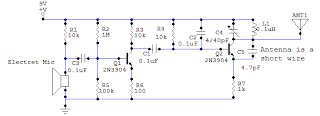Logic Gates explanation article
Logic gates are the basic building blocks of digital electronics. These
are circuits made out of transistors that perform a a logical operation
(see Boolean algebra).
Digital electronics represent data (called
bits) with only two states. Since in electronics we work with voltages,
these two states are most times represented by a presence or lack of
voltage. One (high state) in TTL logic familiy is represented by 5v,
zero (low state) is represented by 0v (ground).
There are three basic gates: AND, OR, and NOT (Inverter).
Other
common gates are NAND, NOR, XOR, XNOR (Equivalence). These gates are
made with combinations of the basic logic gates. Its functions can be
represented using a truth table, which lists every combination of inputs
(A, B) and the resulting output (Z).
AND gate: two input gate, will output 1 when both inputs are 1. It is a one bit multiplication in Boolean algebra.
A B | Z
--------
0 0 | 0
0 1 | 0
1 0 | 0
1 1 | 1
OR gate: two input gate, will output 1 when one or both inputs are 1. It is a one bit addition.
A B | Z
--------
0 0 | 0
0 1 | 1
1 0 | 1
1 1 | 1
NOT gate or Inverter: one input gate, will output 1 when the input is 0 and viceversa.
A | Z
------
0 | 1
1 | 0
NAND gate:
two input gate, same as AND gate but with a NOT at its output. Will
output one as long as both its inputs are NOT 1. if none or one of the
inputs is 0 it will output 1.
A B | Z
--------
0 0 | 1
0 1 | 1
1 0 | 1
1 1 | 0
NOR gate:
two input gate, same as OR gate but with a NOT at its output. Will
output one as long as none of its inputs are 1. if both inputs are 0 it
will output 1.
A B | Z
--------
0 0 | 1
0 1 | 0
1 0 | 0
1 1 | 0
XOR gate:
two input gate, will output 1 when one of its inputs is 1, but not
both. This gate is actually a combination of gates, its boolean equation
is A'B + AB'.
A B | Z
--------
0 0 | 0
0 1 | 1
1 0 | 1
1 1 | 0
XNOR gate
or Equivalence: two input gate, will output 1 when both its inputs are
the same, either 0 or 1. XOR gate with a NOT at its output, its boolean
equation is A'B' + AB.
A B | Z
--------
0 0 | 1
0 1 | 0
1 0 | 0
1 1 | 1
Gate Diagrams:

 Building other gates with NAND and NOR:
Building other gates with NAND and NOR:NAND
and NOR gates have a remarkable characteristic, with enough of either
one of them and connected in a certain way you can actually recreate the
behavior of any other gate. This ability has made them very popular for
large scale manufacturing of logic gates, since it is cheaper to build
only one kind of device instead of having separate machines to create
different logic gates for a single circuit.
Here are the circuit diagrams to create other gates with NAND and NOR.
AND gate:

OR gate:

NOT gate:

NAND gate:

NOR gate:

Since
all digital electronic circuits are made with transistors, you can make
all the above gates using them. When creating logic gates with
transistors, the best option is to make them using NAND, NOR and simple
NOT gates. The benefit of this is that any other gate can be constructed
with a slight variation in the number and configuration of the
transistors, instead of having several different circuits for each gate.
Logic gate's transistor diagrams:NAND gate:

For
this gate, the transistors are connected in series, so that the path
from the output to ground is completed (thus giving 0 as output) only
when both transistors are on (both inputs 1)
NOR gate:

For
the NOR gate, the transistors are connected in parallel, so that the
circuit from the output to ground is closed when either transistor is
on.
NOT gate:

This
gate is the simplest one to build with transistors, the NOT gate
requires only one transistor. Here the transistor is configured so that
when it is on (input 1), the circuit to ground is closed (output 0) and
viceversa.
With these schematics and the above diagrams you
can create a complete digital circuit using only transistors and
resistors. Digital gates are very flexible, but up to a point. When
creating a circuit that has more than three or four inputs, the circuit
becomes too large to build using only logic gates, and that is where
programmable devices come in handy, which we'll discuss in another
article.

















